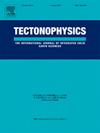云母对实验花岗岩类断层泥强度的影响
IF 2.6
3区 地球科学
Q2 GEOCHEMISTRY & GEOPHYSICS
引用次数: 0
摘要
硅酸片由于其低强度,在塑造地壳流变和浅层剪切局部化中起着重要作用。然而,它们在更深层次(3公里)的影响仍不清楚。我们对石英含量相似但云母类型和含量不同的3个模拟槽进行了热液环剪切实验。施加温度T为20 ~ 650℃,滑动速度V为0.03 ~ 1 μm/s,有效法向应力和孔隙水压力为100 MPa。获得了高达30的剪切应变。在1 μm/s和20℃条件下,花岗岩类的摩擦系数(μ = 0.81)高于富白云母(μ = 0.47)和富黑云母(μ = 0.44);在固定V为1 μm/s的条件下,随着温度的增加,花岗岩类的μ值在650℃时降低至0.61,而富白云母和黑云母的谱线在温度达到200 ~ 450℃时增强(μ = 0.56 ~ 0.69)。在650℃时,随着V的减小,花岗岩类和富白云母泥的强度减弱,而富黑云母泥则没有变化。当V降至0.03 μm/s,温度达到650℃时,花岗岩类比富云母型偏斜岩弱;在650°C时,所有沟槽均呈现μm宽的主滑移带,其显微结构符合溶解-沉淀蠕变(DPC)。这些包括截断的颗粒接触,矿物沉淀,亚微米粒度和低孔隙率。当富白云母的泥质减弱时,会发生白云母的破裂和黑云母的形成。研究结果表明,花岗岩类断层中云母的富集可导致上地壳弱而中地壳强,因为上地壳弱于花岗岩类断层。DPC的发生可能引发绿片岩相深度的摩擦-粘性转变。本文章由计算机程序翻译,如有差异,请以英文原文为准。
The effect of micas on the strength of experimental granitoid fault gouge
Sheet silicates play an important role in shaping crustal rheology and shear localization at shallow depths through their low strength. However, their effect at deeper levels (>3 km) remains unclear. We conducted hydrothermal ring shear experiments on three simulated gouges with similar quartz content but varying mica types and contents. Applied temperatures ranged from 20 to 650 °C, with sliding velocities between 0.03 and 1 μm/s, and an effective normal stress and pore water pressure of 100 MPa. Shear strains up to 30 were attained.
At 1 μm/s and 20 °C, granitoids exhibit a higher friction coefficient (μ = 0.81) than the muscovite-rich (μ = 0.47) and biotite-rich gouges (μ = 0.44). With increasing at a fixed of 1 μm/s, μ of granitoids decreases to 0.61 at 650 °C, whereas muscovite- and biotite-rich gouges strengthen (μ = 0.56–0.69) until T reaches 200–450 °C. At 650 °C, weakening is observed in granitoid and muscovite-rich gouges as decreases, while biotite-rich gouge shows no change. Granitoids are weaker than the mica-rich gouges once decreases to 0.03 μm/s and reaches 650 °C. All gouges at 650 °C exhibit μm-wide principal slip zones, featuring microstructures consistent with dissolution-precipitation creep (DPC). These include truncated grain contacts, mineral precipitates, submicrometer grain size and low porosity. Muscovite breakdown and biotite formation occurs in muscovite-rich gouge as they weaken. Our results imply that mica enrichment in granitoid faults can lead to a weaker upper crust and stronger middle crusts as they weaken less than granitoids. The onset of DPC may trigger a frictional-viscous transition at greenschist facies depths.
求助全文
通过发布文献求助,成功后即可免费获取论文全文。
去求助
来源期刊

Tectonophysics
地学-地球化学与地球物理
CiteScore
4.90
自引率
6.90%
发文量
300
审稿时长
6 months
期刊介绍:
The prime focus of Tectonophysics will be high-impact original research and reviews in the fields of kinematics, structure, composition, and dynamics of the solid arth at all scales. Tectonophysics particularly encourages submission of papers based on the integration of a multitude of geophysical, geological, geochemical, geodynamic, and geotectonic methods
 求助内容:
求助内容: 应助结果提醒方式:
应助结果提醒方式:


